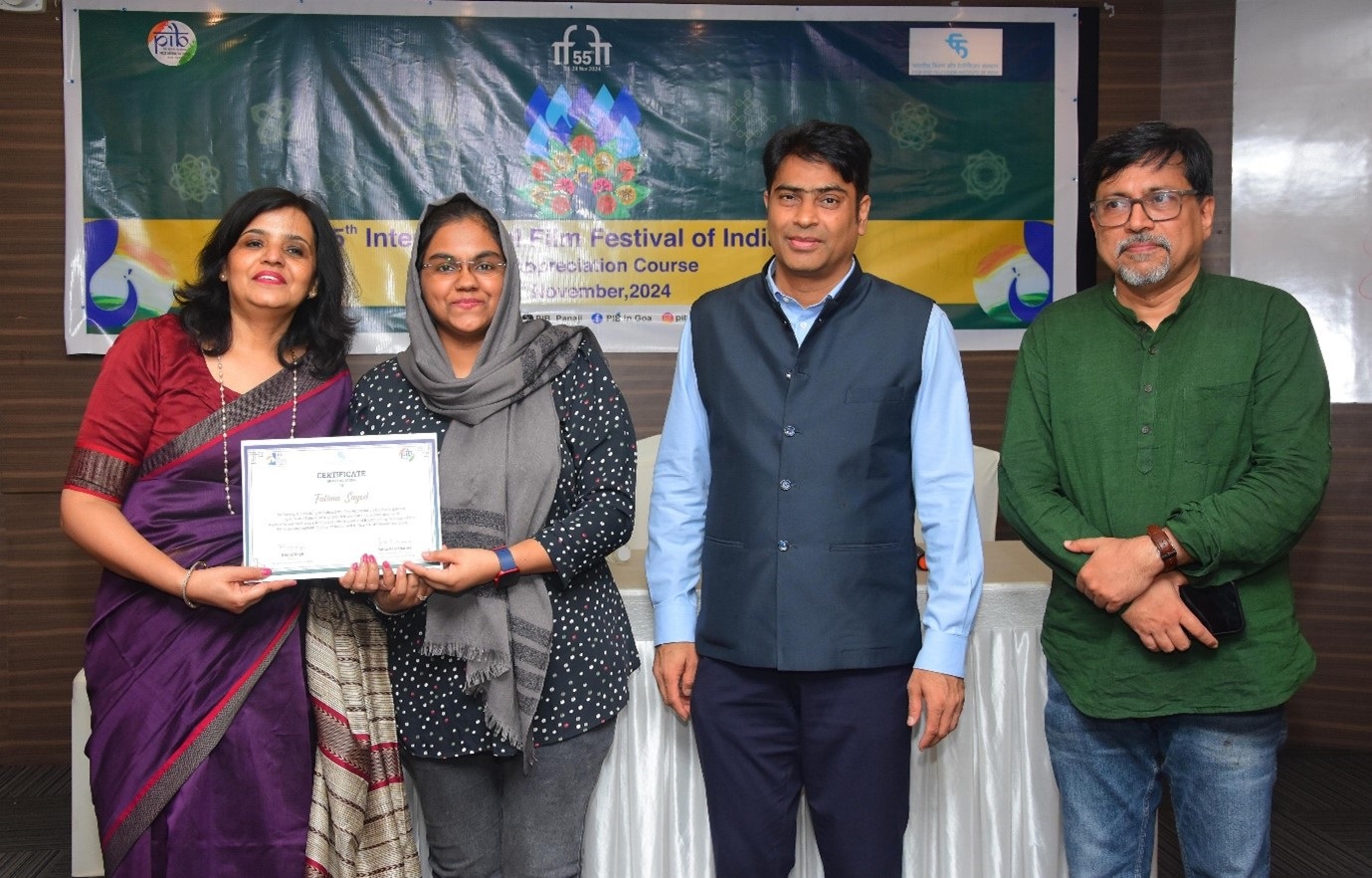Course focused on exploring various aspects of art and craft of films

THE GOAN NETWORK
PANAJI
The Press Information Bureau (PIB), Ministry of Information & Broadcasting, in collaboration with the Film and Television Institute of India (FTII), Pune, organised an engaging Film Appreciation Course on ‘Reviewing Films: From Critiquing to Reading Cinema’ for media delegates on the sidelines of the 55th International Film Festival of India (IFFI) in Goa. The course was organised exclusively for IFFI media delegates focused on exploring the various aspects of the art and craft of films and the importance of learning to read the films in an informed manner. The course was led by industry experts such as Dr Indranil Bhattacharya, Prof Amlan Chakraborty, and Malini Desai from FTII, Pune.
The participants were introduced to 'Principles of Film Analysis,' by Prof Dr Indranil Bhattacharya. This was followed by a session on 'Editing as an Artistic Tool’ led by Prof Amlan Chakraborty. In another engaging session, Prof Malini Desai explored the significance of ‘Lighting as a Dramatic Tool.’
Prof Amlan Chakraborty also highlighted the importance of film appreciation, stating that “Film appreciation is not just about admiration but about understanding. Every film is designed to impact its audience. Some films stay with you, and you need to ask why.” He illustrated the deeper sociological meanings embedded within films illustrating the example of India's official entry for Oscars 2025, Lapata Ladies.
Later, Prof Bhattacharya conducted a special session focused on the analysis of short films, offering participants valuable insights into the structure and storytelling techniques of short-form cinema.
Managing Director, NFDC Pritul Kumar thanked the media for their active participation and stressed the significant role played by media in promoting films. Speaking about the importance of understanding films, he mentioned that the Film Appreciation Course will be really helpful in delving deep into the world of films which will enrich the media in understanding and writing about them.
Director General West Zone, M/o I&B. Smita Vats Sharma while addressing the participants informed that the course was open to media across India, including both Goan and all-India representatives as Media plays a critical role in the celebration of cinema and taking the films across the country and the world, and hence this course has been timed during IFFI to facilitate our media professionals. She also thanked FTII for their invaluable support in making this possible.
Joint Director, PIB Mumbai, Sayyid Rabeehashmi emphasised the need to not only celebrate films but also delve into their intricate details.
Speaking about the significance of such initiatives, Prof Malini Desai emphasised that media plays an essential role in exchanging ideas and helping the world understand the art of cinema. And as filmmakers we are also communicating our perspectives to the audience. This interaction between media and filmmakers - both of whom are into ‘communication’ greatly enriched our understanding about each other’s perspective.
Appreciating the initiative, journalist and participant, Harshita from Screen Grafia who has been covering IFFI since 1999, said that this is a great initiative by the Ministry to educate film journalists. It will expand their knowledge about films. I hope this course is repeated in future editions too.
Satyendar Mohan, a veteran journalist who has been attending IFFI for four decades expressed that I’ve been attending IFFI since 1983. This session was very informative and educational. It will help journalists appreciate films on a much deeper level, adding immense value to the 55th IFFI.
The event concluded with a valedictory session. Certificates were distributed to more than 30 media delegates who attended the session, acknowledging their efforts in advancing their understanding of film appreciation.
IFFI to include opening ceremony
with sign language interpretation
PANAJI:
For the first time in its history, the International Film Festival of India (IFFI) will include live Indian Sign Language interpretation at the inaugural ceremony. This move ensures that the event is accessible to all attendees, including those with hearing impairments, allowing everyone to fully participate and enjoy the celebration.
The 55th edition of IFFI, set to take place in Goa, promises to be a grand showcase of cinematic art and creativity. With anticipation building, film enthusiasts from across India and the world eagerly await the week-long celebration of cinematic talent at IFFI 2024.
Youth are showing increasing interest
in films: Indranil Bhattacharya
THE GOAN NETWORK
PANAJI
India produces the highest amount of films, and a large number of audience watches them too. We also make quality films, but as they are not understood much by the westerners, these films lag behind, stated Prof Dr Indranil Bhattacharya from Indian Films and Television Institute.
Most of the films made in India contain all kinds of emotions (Nav Ras) but the western films are centred on one theme. India too is adopting this method and making films issue focussed films. Youth are showing growing interest in the international films, said Dr Bhattacharya who was addressing a film review workshop conducted jointly by the Press Information Bureau and Indian Films and Television Institution for the media representatives.
Claiming that the film industry has a bright future, Dr Bhattacharya refuted the claims that the film industry is being endangered by digital mediums. The film industry has been settled now and has a good future, he asserted.
He further explained that any incident or scene occurring in the story of the film in a particular period or place is all pre-planned and pre-scheduled. No incident or scene is spontaneously created or added to the script. Minute work is being put in, in all aspects of the film, including the story, concept, acting, presentation etc. That’s why while reviewing/watching a film, one has to take into consideration of all these different aspects too, underlined Dr Bhattacharya.